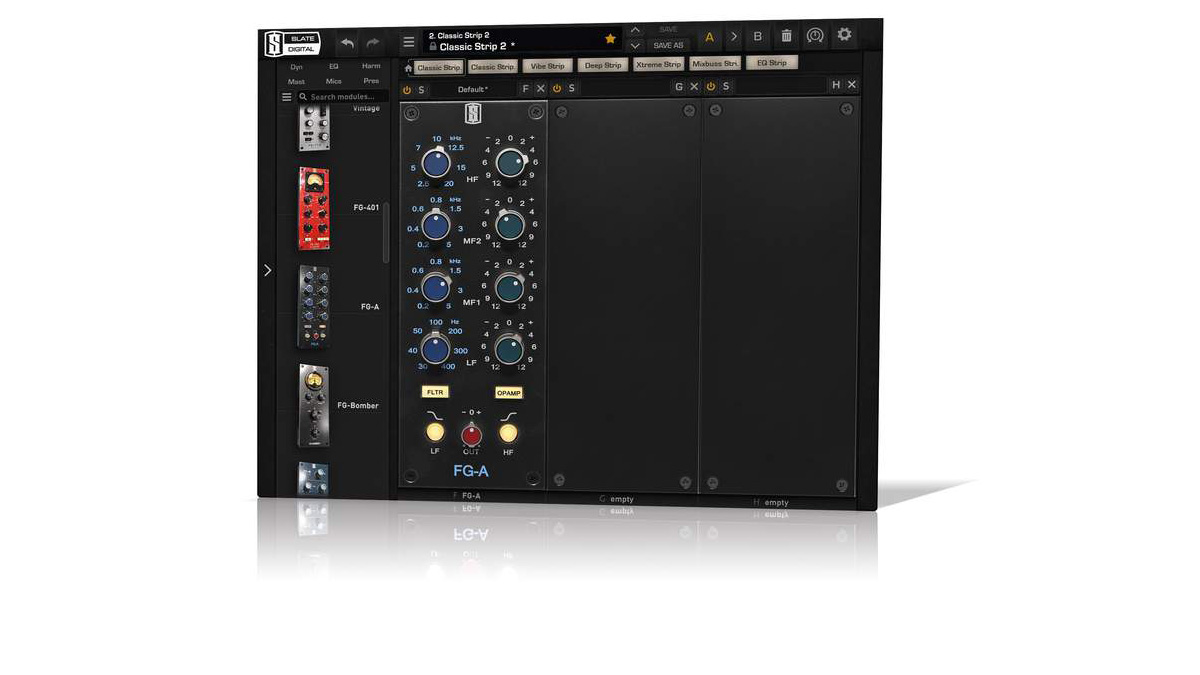MusicRadar Verdict
An API 550a emulation with - ahem - knobs on, and the most convincing representation we’ve heard to date.
Pros
- +
Sounds and behaves just like the API 550a.
- +
Stepped and continuous knobs Two mid bands.
- +
Optional Op Amp saturation.
Cons
- -
Only available within the Virtual Mix Rack 2 shell.
MusicRadar's got your back
The latest addition to Steven Slate and Fabrice Gabriel’s line-up of analogue modelling processors for Virtual Mix Rack (see Back in the Rack), FG-A is an emulation of the revered API 550 EQ.
Famed for its highly ‘musical’ sound, the 550 employs a proportional Q design, whereby the width of each band narrows as the gain increases or decreases from zero. Thus, low gain adjustments are kept broad for subtle shaping and sweetening, while more extreme cuts or boosts are sharper for surgical corrective work. FG-A sets out to accurately replicate this behaviour and capture the sound and response of the real thing.
Freakin’ A
FG-A is a four-band EQ, offering up to 12dB of cut or boost for each band, plus optional 50Hz-15kHz band-passing with the Filter button engaged. Interestingly, though, it doesn’t model the four-band 550b hardware, but rather the three-band 550a with the 0.2-5kHz mid band doubled up. The high and low bands, meanwhile, range from 2.5-20kHz and 30-400Hz, and are switched from peak to shelving response using the LF and HF buttons.
Rather than copy the dual concentric knobs of the hardware, with their anticlockwise frequency ranges, each of FG-A’s four bands has dedicated knobs for frequency and gain, with the former arranged clockwise. And while the knobs of the 550 are stepped, snapping to seven specific frequencies per band, and five positive or negative gain levels, here, right-click- dragging rotates them continuously for far greater precision. Not all virtual 550s can do this, and it’s a very welcome enhancement.
FG-A is deployed as a module within Slate Digital’s Virtual Mix Rack 2. This is a modular channel strip plugin (VST/AU/AAX), graphically referencing the API 500 ‘lunchbox’ format, in which up to eight modules from a regularly expanding range of analogue-style compressors, EQs and other processors - including the superb Virtual Console and Virtual Tube Collections - are chained in series. You can buy modules individually or, alternatively, ‘unlock’ the whole lot with an All Access subscription.
VMR 2 itself doesn’t offer any meaningful functionality beyond the ability to save out effects chains as presets, and the hooking up of host automation assignments, but the exceptional quality of the modules make it without doubt one of the most compelling ‘in the box’ mixing tools around. We wish said modules could be loaded as self-contained plugins, too, however.
The Opamp button activates a modelled simulation of the original 550’s discrete 2520 op amps and transformers, working analogue saturation into the signal, pre or post EQ, depending on the settings of individual bands, and even - so they say - between adjacent bands. This adds another dimension to the sound, thickening transients and generally warming things up a bit.
Slate also boast that FG-A’s high band can be pushed to extreme levels without harshness or distortion, and we can confirm that this is indeed the case. No matter how much gain you pile on, those high frequencies hold that characteristic sheen and airiness together beautifully.
Proportional representation
Thanks to its proportional Q design, FG-A is just as at home zooming in on a snare drum or problem vocal frequency as it is gently boosting the bottom end of a mix. And the continuous knob movement is so useful that we’d prefer it to be the default, rather than a ‘modified’ option, although we can fully understand Slate wanting to respect the hardware blueprint.
There are several excellent API 550 emulations on the market already, but Slate’s take on this most coveted of signal processors really is something special, thanks in large part to the continuous knobs and the luxurious saturation it brings to the party. There’s essentially nothing we can fault in this near-perfect virtualisation of one of the most intuitive, foolproof and sonically satisfying equalisers ever made.
Computer Music magazine is the world’s best selling publication dedicated solely to making great music with your Mac or PC computer. Each issue it brings its lucky readers the best in cutting-edge tutorials, need-to-know, expert software reviews and even all the tools you actually need to make great music today, courtesy of our legendary CM Plugin Suite.
Baby Audio's Smooth Operator spectral balancing plugin goes pro
"It was ugly, like watching a divorce between four people. After a while, I had to get out": Beatles engineer Geoff Emerick on the recording of Abbey Road, track-by-track
"I said, “What’s that?” and they said, “It’s what Quincy Jones and Bruce Swedien use on all the Michael Jackson records": Steve Levine reminisces on 50 years in the industry and where it’s heading next











